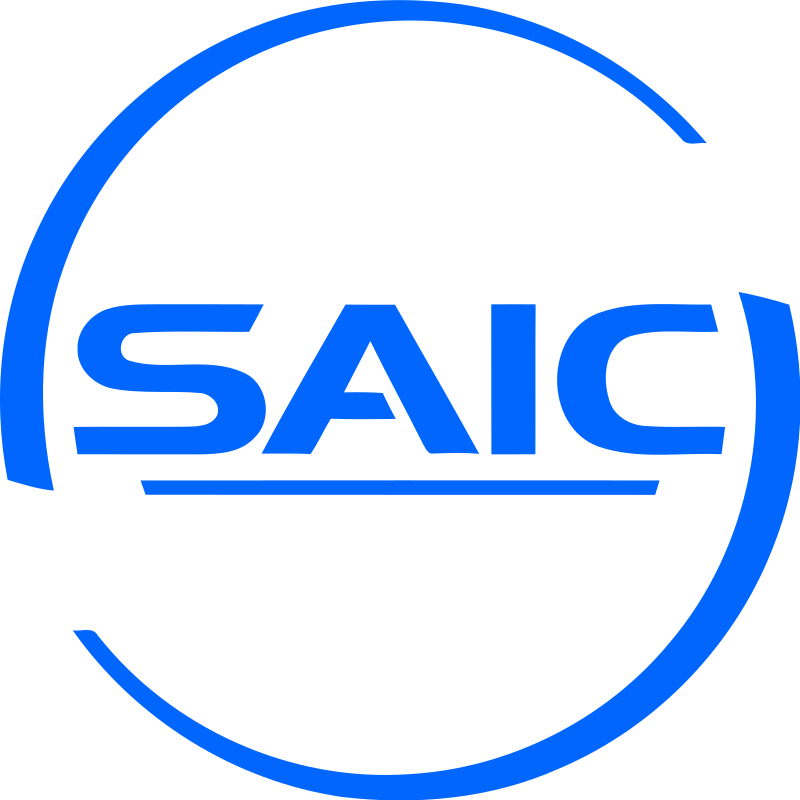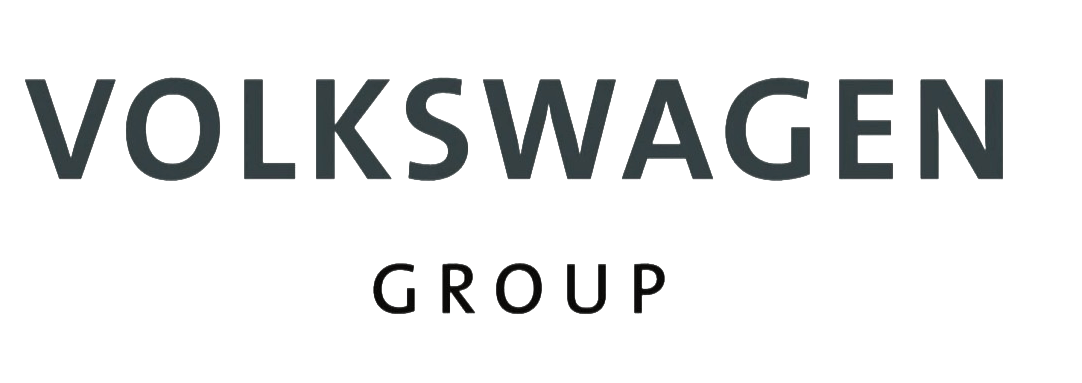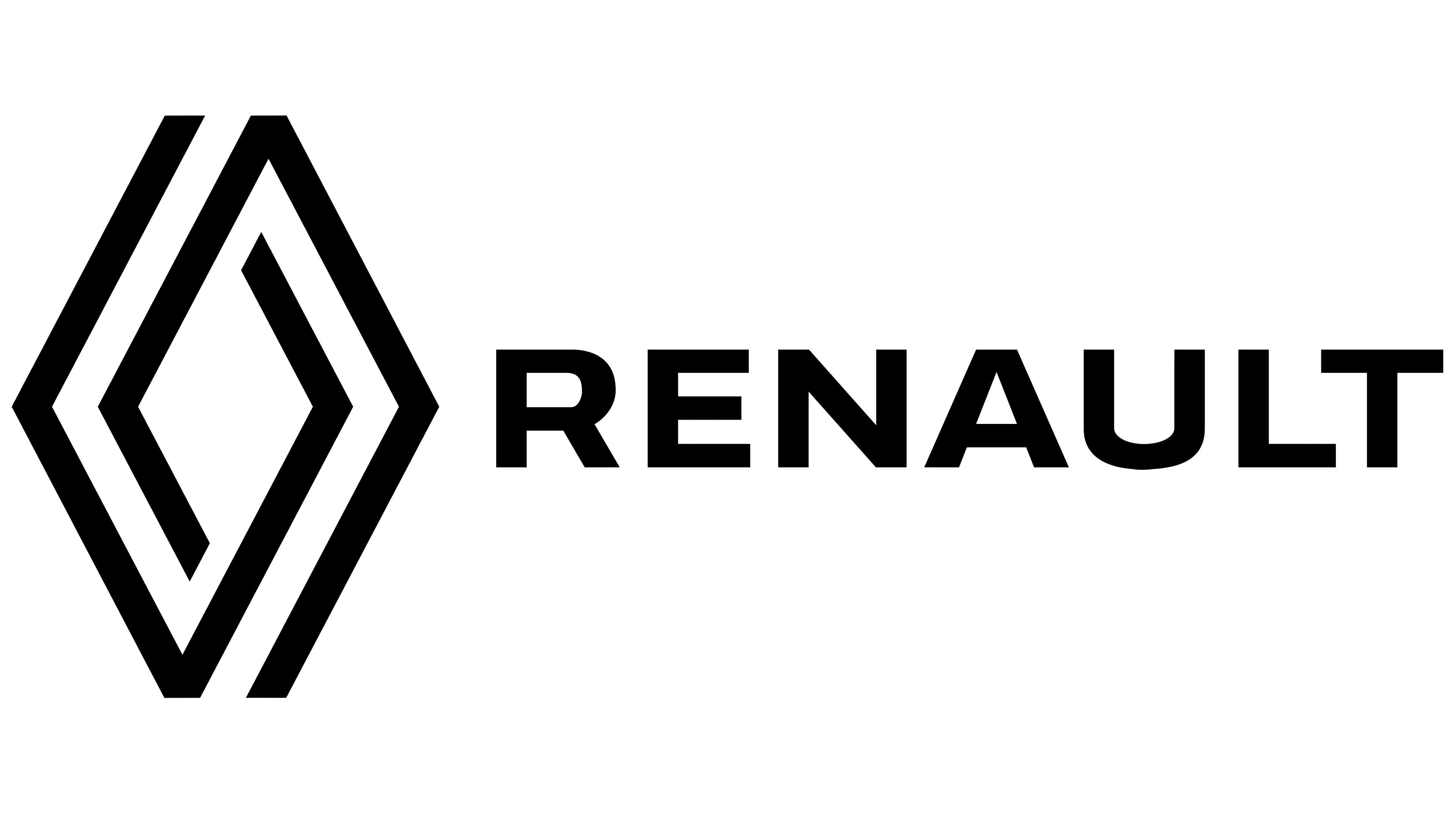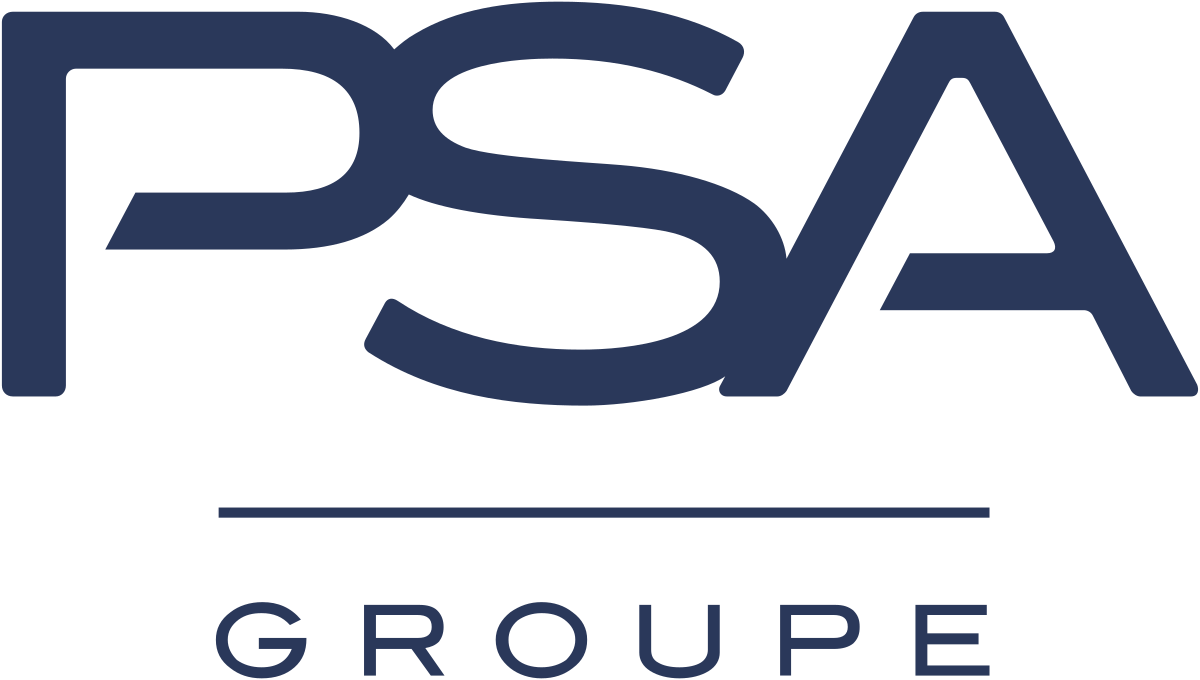Global Railway Propulsion System Market By Type, By Application, By End User & By Region: Global Insights, Comparative Analysis, Trends and Forecast, 2015 – 2031
- Industry: Automotive & Transportation
- Report ID: TNR-110-982
- Number of Pages: 420
- Table/Charts : Yes
- November, 2023
- Base Year : 2024
- No. of Companies : 10+
- No. of Countries : 29
- Views : 10163
- Covid Impact Covered: Yes
- War Impact Covered: Yes
- Formats : PDF, Excel, PPT
Global Railway Propulsion Market System Registered Revenue of US$ 9.23 Billion in 2022, Growing at an Estimated CAGR of 4.2% from 2023 – 2031
A railway propulsion market refers to the mechanism responsible for generating and transmitting the required power to move trains along the tracks. It encompasses various technologies, such as engines, motors, and transmission systems that convert energy sources like electricity, diesel, or hybrid systems into mechanical force. In electric systems, overhead wires or third rails provide the power source, which is then converted by electric motors to drive the wheels. Diesel systems use internal combustion engines to drive generators that produce electricity for the motors. The efficiency, environmental impact, and speed of trains are heavily influenced by the design and performance of the propulsion system. These systems play a pivotal role in ensuring reliable, safe, and efficient railway transportation.
The electric propulsion system type asserts dominance in the global railway propulsion system market. According to data from the International Union of Railways (UIC), electrically propelled trains constitute a significant majority of the global railway network. This trend is reinforced by a survey conducted by the Railway Gazette International, which revealed that approximately 75% of new train orders were for electric-powered units. The substantial investment in electrification projects, like Europe’s comprehensive high-speed rail network, underscores the prominence of electric propulsion due to its efficiency, reduced emissions, and consistent performance.
Global Railway Propulsion System Market Revenue & Forecast, (US$ Million), 2015 – 2031

COVID-19 Impact Analysis on Global Railway Propulsion System Market
Pre-COVID-19, the railway propulsion system market was on a steady trajectory, with electrification projects gaining momentum globally. Governments and rail operators were investing heavily in sustainable transportation solutions, resulting in a shift towards electric and hybrid systems. However, the pandemic disrupted supply chains, leading to project delays and decreased investments. Post-COVID-19, as economies recover, the railway propulsion system market is rebounding. The emphasis on sustainability remains strong, accelerating the transition to electric and hybrid systems. Additionally, the pandemic underscored the need for resilient transportation networks, further encouraging rail modernization efforts. As demand for efficient and eco-friendly propulsion systems rises, the market is adapting to meet the evolving requirements of a changing world.
Report Coverage and Deliverables
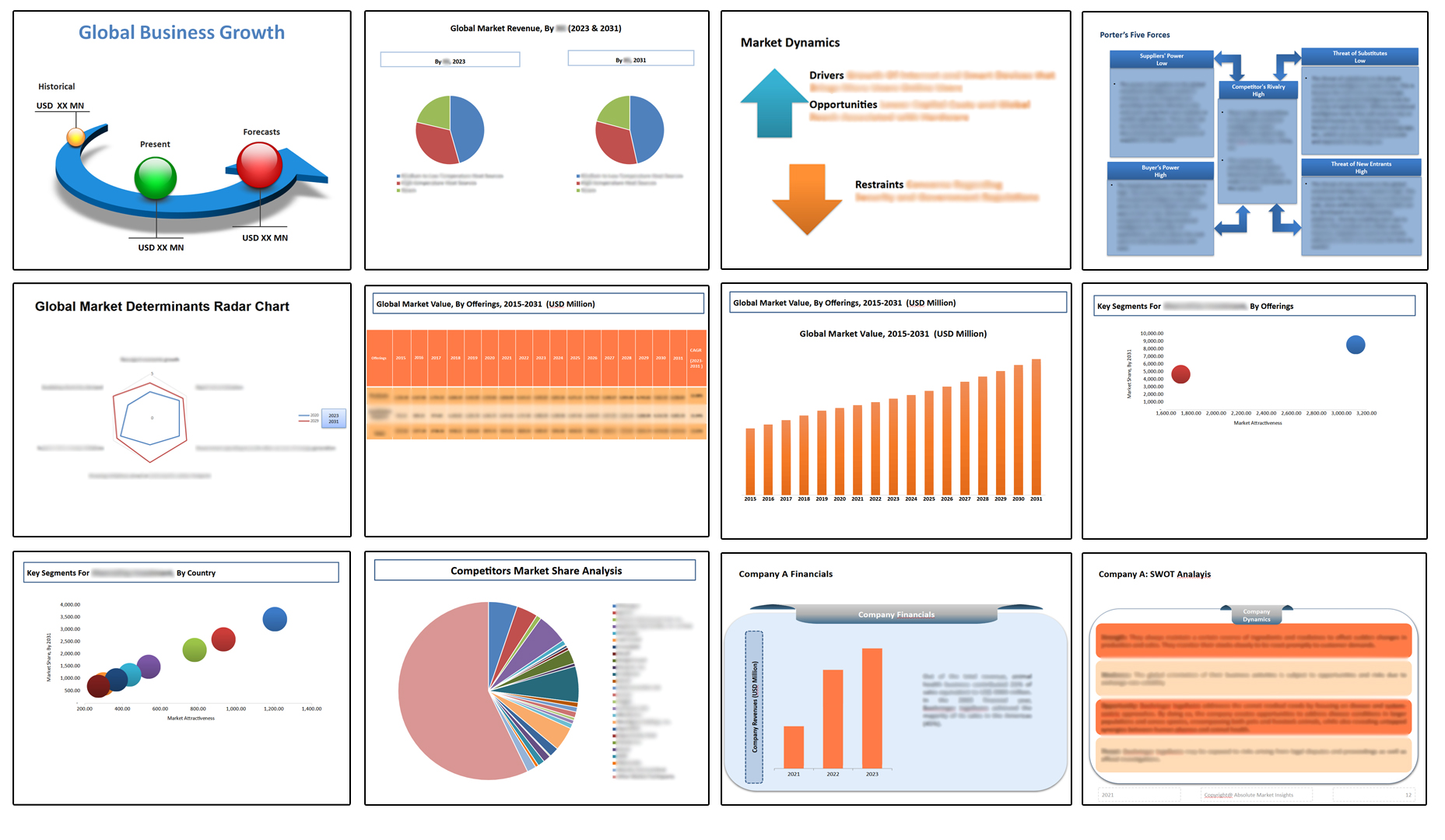
Environmental sustainability is a pivotal driver in the railway propulsion system market. A survey by the International Union of Railways (UIC) highlighted that 90% of respondents identified reducing carbon emissions as a top priority. Data from the International Energy Agency (IEA) indicated that rail transport emits significantly fewer greenhouse gases compared to road or air transport. Governments globally are setting ambitious emission reduction targets, and the rail sector is seen as a key contributor to achieving these goals. Investments in electrification and hybrid systems are fueled by the need to align with environmental standards, attracting support from both public and private sectors. Infrastructure constraints pose a notable restraint in the railway propulsion system market.
A database analysis of rail projects indicated that around 40% of existing rail networks remain non-electrified. The cost and complexity of electrification projects, especially in remote areas, hinder the swift transition to electric propulsion. This is further emphasized by data from the Railway Gazette International, which revealed that electrification investments decreased by 15% in certain regions due to budget constraints.
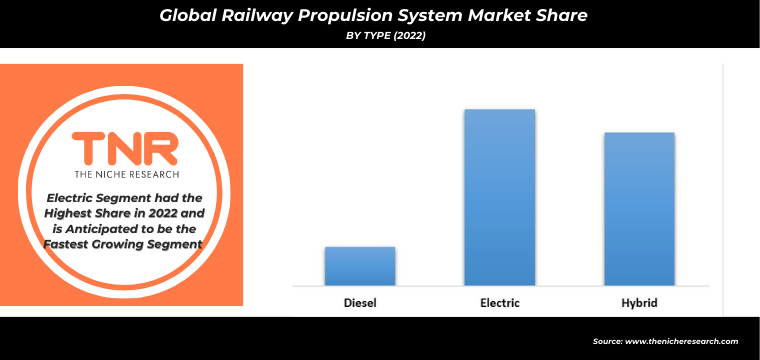
The locomotive application holds dominance in the global railway propulsion system market. According to data from the International Union of Railways (UIC), locomotives constitute the majority of rolling stock in operation worldwide. A survey conducted by the Railway Gazette International reaffirmed this, indicating that 70% of new rolling stock orders were for locomotives. This prevalence is driven by the diverse roles locomotives play, from freight and passenger transport to intercity and long-haul operations.
North America dominated the global railway propulsion system market in 2022. According to data from the International Union of Railways (UIC), North America boasts one of the most extensive and advanced rail networks globally. Furthermore Europe has also been in the forefront in the railway propulsion system market. The European Commission’s initiatives to enhance rail connectivity, such as the Trans-European Transport Network (TEN-T), have contributed to this dominance. A survey conducted by Eurostat found that over 60% of passenger-kilometers traveled in Europe were by rail. The extensive intercity and high-speed rail networks, exemplified by projects like France’s TGV and Germany’s ICE, underscore Europe’s prominence in the railway propulsion system market.
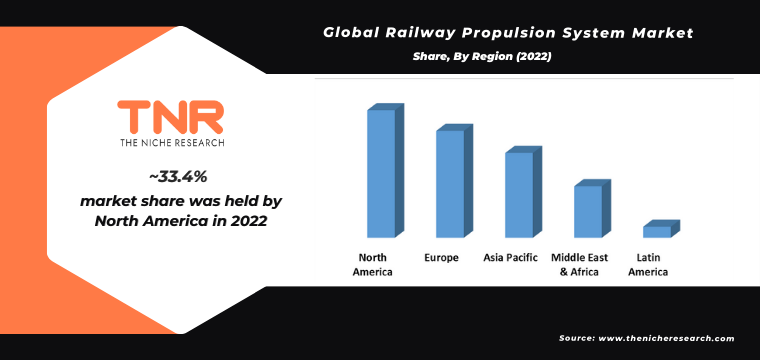
Competitive Landscape
The report provides both, qualitative and quantitative research of global railway propulsion system market, as well as provides comprehensive insights and development methods adopted by the key contenders. The report also offers extensive research on the key players in this market and details on the competitiveness of these players. Key business strategies such as mergers and acquisitions (M&A), affiliations, collaborations, and contracts adopted by these major market participants are also recognized and analyzed in the report. For each company, the report studies their global presence, competitors, service offerings and specification amongst others.
Some of the players operating in the global railway propulsion system market are
- ABB
- Alstom
- CRRC Corporation Limited
- Fuji Electric Co., Ltd.
- Hitachi, Ltd.
- MEDCOM Sp. z o.o.
- Mitsubishi Corporation
- Siemens
- Titagarh Rail Systems Limited
- Toshiba Corporation
- Other Industry Participants
Report Summary of Global Railway Propulsion Market
| Report Specifications | Details |
| Market Revenue in 2022 | US$ 9.23 Billion |
| Market Size Forecast by 2031 | US$ 13.46 Billion |
| Growth Rate (CAGR) | 4.2% |
| Historic Data | 2015 – 2021 |
| Base Year for Estimation | 2022 |
| Forecast Period | 2023 – 2031 |
| Report Inclusions | Market Size & Estimates, Market Dynamics, Competitive Scenario, Trends, Growth Factors, Market Determinants, Key Investment Segmentation, Product/Service/Solutions Benchmarking |
| Segments Covered | By Type, By Application, By End User |
| Regions Covered | North America, Europe, Asia Pacific, Middle East & Africa, Latin America |
| Countries Covered | U.S., Canada, Mexico, Rest of North America, France, The UK, Spain, Germany, Italy, Nordic Countries (Denmark, Finland, Iceland, Sweden, Norway), Benelux Union (Belgium, The Netherlands, Luxembourg), Rest of Europe, China, Japan, India, New Zealand, Australia, South Korea, Southeast Asia (Indonesia, Thailand, Malaysia, Singapore, Rest of Southeast Asia), Rest of Asia Pacific, Saudi Arabia, UAE, Egypt, Kuwait, South Africa, Rest of Middle East & Africa, Brazil, Argentina, Rest of Latin America |
| Key Players | ABB, Alstom, CRRC Corporation Limited, Fuji Electric Co., Ltd., Hitachi, Ltd., MEDCOM Sp. z o.o., Mitsubishi Corporation, Siemens, Titagarh Rail Systems Limited, Toshiba Corporation, Other Industry Participants |
| Customization Scope | Customization allows for the inclusion/modification of content pertaining to geographical regions, countries, and specific market segments. |
| Pricing & Procurement Options | Explore purchase options tailored to your specific research requirements |
| Contact Details | Consult With Our Expert
Japan (Toll-Free): – +81 663-386-8111 South Korea (Toll-Free): – +82-808- 703-126 Saudi Arabia (Toll-Free): – +966 800 850 1643 United States: +1 302-232-5106 United Kingdom: +447537105080 E-mail: askanexpert@thenicheresearch.com
|
Global Railway Propulsion System Market:
By Type
- Diesel
- Electric
- Hybrid
By Application
- Locomotive
- Metro
- Monorail
- Trams
- Others
By End User
- Passenger Transit
- Cargo Transit
By Region
- North America (U.S., Canada, Mexico, Rest of North America)
- Europe (France, The UK, Spain, Germany, Italy, Nordic Countries (Denmark, Finland, Iceland, Sweden, Norway), Benelux Union (Belgium, The Netherlands, Luxembourg), Rest of Europe)
- Asia Pacific (China, Japan, India, New Zealand, Australia, South Korea, Southeast Asia (Indonesia, Thailand, Malaysia, Singapore, Rest of Southeast Asia), Rest of Asia Pacific)
- Middle East & Africa (Saudi Arabia, UAE, Egypt, Kuwait, South Africa, Rest of Middle East & Africa)
- Latin America (Brazil, Argentina, Rest of Latin America)
Table of Contents
**Exclusive for Multi-User and Enterprise User.
Global Railway Propulsion System Market Segmentation
By Type
By Application
By End User
By Region
**Note: The report covers cross-segmentation analysis by region further into countries
The Niche Research approach encompasses both primary and secondary research methods to provide comprehensive insights. While primary research is the cornerstone of our studies, we also incorporate secondary research sources such as company annual reports, premium industry databases, press releases, industry journals, and white papers.
Within our primary research, we actively engage with various industry stakeholders, conducting paid interviews and surveys. Our meticulous analysis extends to every market participant in major countries, allowing us to thoroughly examine their portfolios, calculate market shares, and segment revenues.
Our data collection primarily focuses on individual countries within our research scope, enabling us to estimate regional market sizes. Typically, we employ a bottom-up approach, meticulously tracking trends in different countries. We analyze growth drivers, constraints, technological innovations, and opportunities for each country, ultimately arriving at regional figures.Our process begins by examining the growth prospects of each country. Building upon these insights, we project growth and trends for the entire region. Finally, we utilize our proprietary model to refine estimations and forecasts.
Our data validation standards are integral to ensuring the reliability and accuracy of our research findings. Here’s a breakdown of our data validation processes and the stakeholders we engage with during our primary research:
- Supply Side Analysis: We initiate a supply side analysis by directly contacting market participants, through telephonic interviews and questionnaires containing both open-ended and close-ended questions. We gather information on their portfolios, segment revenues, developments, and growth strategies.
- Demand Side Analysis: To gain insights into adoption trends and consumer preferences, we reach out to target customers and users (non-vendors). This information forms a vital part of the qualitative analysis section of our reports, covering market dynamics, adoption trends, consumer behavior, spending patterns, and other related aspects.
- Consultant Insights: We tap into the expertise of our partner consultants from around the world to obtain their unique viewpoints and perspectives. Their insights contribute to a well-rounded understanding of the markets under investigation.
- In-House Validation: To ensure data accuracy and reliability, we conduct cross-validation of data points and information through our in-house team of consultants and utilize advanced data modeling tools for thorough verification.
The forecasts we provide are based on a comprehensive assessment of various factors, including:
- Market Trends and Past Performance (Last Five Years): We accurately analyze market trends and performance data from preceding five years to identify historical patterns and understand the market’s evolution.
- Historical Performance and Growth of Market Participants: We assess the historical performance and growth trajectories of key market participants. This analysis provides insights into the competitive landscape and individual company strategies.
- Market Determinants Impact Analysis (Next Eight Years): We conduct a rigorous analysis of the factors that are projected to influence the market over the next eight years. This includes assessing both internal and external determinants that can shape market dynamics.
- Drivers and Challenges for the Forecast Period:Identify the factors expected to drive market growth during the forecast period, as well as the challenges that the industry may face. This analysis aids in deriving an accurate growth rate projection.
- New Acquisitions, Collaborations, or Partnerships: We keep a close watch on any new acquisitions, collaborations, or partnerships within the industry. These developments can have a significant impact on market dynamics and competitiveness.
- Macro and Micro Factors Analysis:A thorough examination of both macro-level factors (e.g., economic trends, regulatory changes) and micro-level factors (e.g., technological advancements, consumer preferences) that may influence the market during the forecast period.
- End-User Sentiment Analysis: To understand the market from the end-user perspective, we conduct sentiment analysis. This involves assessing the sentiment, preferences, and feedback of the end-users, which can provide valuable insights into market trends.
- Perspective of Primary Participants: Insights gathered directly from primary research participants play a crucial role in shaping our forecasts. Their perspectives and experiences provide valuable qualitative data.
- Year-on-Year Growth Trend: We utilize a year-on-year growth trend based on historical market growth and expected future trends. This helps in formulating our growth projections, aligning them with the market’s historical performance.
Research process adopted by TNR involves multiple stages, including data collection, validation, quality checks, and presentation. It’s crucial that the data and information we provide add value to your existing market understanding and expertise. We have also established partnerships with business consulting, research, and survey organizations across regions and globally to collaborate on regional analysis and data validation, ensuring the highest level of accuracy and reliability in our reports.


